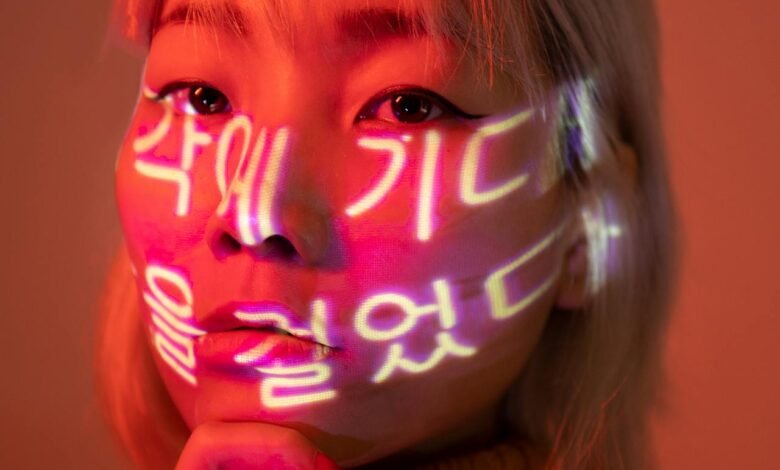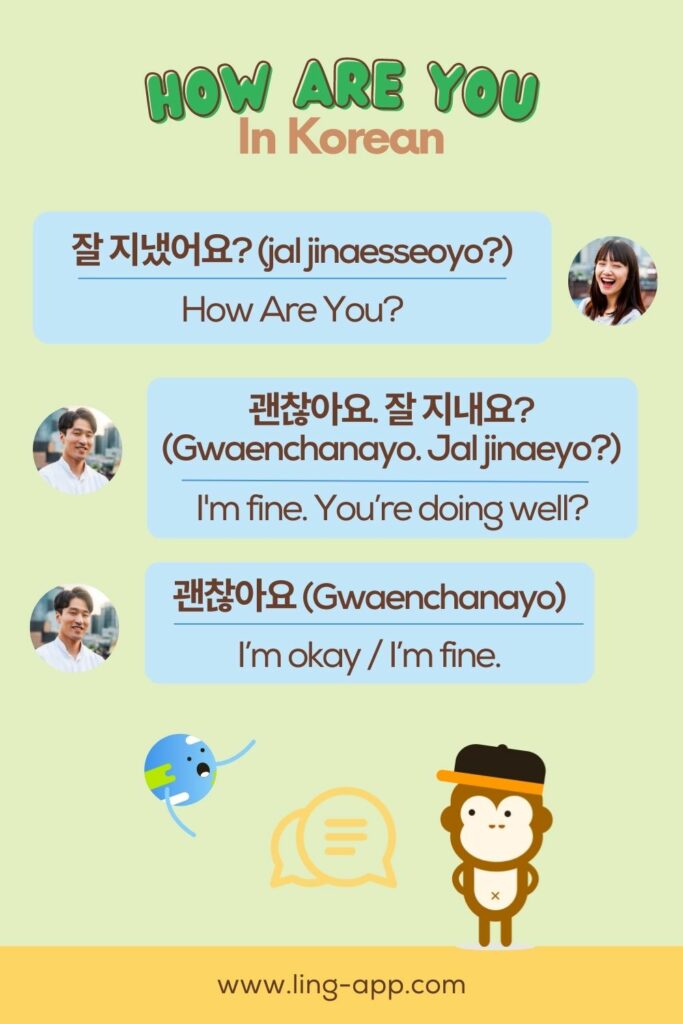How are You in Korean: Unlocking Cultural Connection

How are You in Korean? In Korean, “How are you?” Is translated as “어떻게 지내세요?”
(eotteohke jinaeseyo? ). This phrase is commonly used in Korean to ask about someone’s well-being or to greet them. Now, let’s dive into a well-rounded introduction. Greetings and expressions of well-being are essential in any language, and Korean is no exception.
From a simple “안녕하세요? ” (annyeonghaseyo? ) To asking “How are you? ” In Korean, these phrases allow us to connect with others on a personal level. In this blog post, we will explore how to ask someone “How are you? ” In Korean and delve into the cultural nuances surrounding this common greeting. Understanding the proper usage and context of this phrase will not only help you communicate effectively but also show respect towards Korean culture. So, let’s get started on this linguistic journey of greeting and well-being in Korean!

Credit: ling-app.com
Introduction To Korean Greetings
Explore the world of Korean greetings with a focus on “How are you” in Korean. Discover the cultural nuances and common phrases used in everyday interactions. Master the art of exchanging pleasantries in the Korean language effortlessly.
Korean culture is known for its emphasis on respect and formalities, and this is reflected in the way people greet each other. Greetings play an important role in Korean society, and knowing how to greet someone properly is crucial for building relationships and showing respect. In this blog post, we will be discussing the different ways to say “How are You in Korean” as well as the importance of greetings in Korean culture.
The Importance Of Greetings In Korea
In Korea, greetings are more than just a formality – they are a way of showing respect and acknowledging someone’s presence. Koreans take great pride in their culture and traditions, and showing respect to others is a fundamental aspect of this culture. Therefore, it is important to greet people properly in order to establish a good impression and build a positive relationship.
Setting The Stage For Cultural Exchange
In addition to showing respect, greetings also play an important role in setting the stage for cultural exchange. When meeting someone from a different culture, the way you greet them can have a significant impact on how they perceive you and your culture. By taking the time to learn and understand the proper way to greet someone in their culture, you are showing that you respect and value their customs. This can help to build a bridge between cultures and facilitate a more meaningful exchange.
In conclusion, understanding the importance of greetings in Korean culture is crucial for anyone looking to build relationships or engage in cultural exchange. By taking the time to learn and understand the proper way to greet someone in Korean, you can show respect, build relationships, and create a more positive exchange.
Basic Korean Greetings
Basic Korean Greetings are essential for effective communication. Let’s delve into the fascinating world of Korean greetings.
The Universal ‘annyeonghaseyo’
In Korean culture, ‘Annyeonghaseyo’ is a universal greeting used in both formal and informal settings.
Formal And Informal Variants
- Formal: Use ‘Annyeonghaseyo’ to show respect in formal situations.
- Informal: ‘Annyeong’ is a casual variant used among friends and peers.
Delving Into ‘how Are You?’
When learning a new language, one of the first phrases we often come across is “How are you?” It’s a simple greeting that allows us to connect with others and show our interest in their well-being. In Korean, the phrase “How are you?” is expressed as “Eotteoke jinaeseyo?”.
Eotteoke Jinaeseyo? In Context
In Korean culture, it’s common to greet someone by asking “Eotteoke jinaeseyo?” It’s a polite way to inquire about someone’s well-being and is often used in formal or casual settings. Whether you’re meeting someone for the first time or catching up with an old friend, this phrase serves as a friendly icebreaker. By asking “Eotteoke jinaeseyo?” you show that you care about the other person’s welfare.
Nuances In The Korean Language
Like any language, Korean has its own unique nuances and cultural aspects. When it comes to asking “How are you?” in Korean, it’s important to consider these nuances to ensure effective communication. In Korean culture, expressing genuine interest and concern for the other person is highly valued. Therefore, when asking “Eotteoke jinaeseyo?”, it’s essential to use polite language and appropriate honorifics, depending on the person’s age or social status.
Additionally, the response to “Eotteoke jinaeseyo?” differs from the typical “I’m fine” or “I’m good” in English. In Korean, it is common to respond with a more detailed answer, providing specific information about one’s well-being or current situation. This reflects the emphasis on building deeper connections and fostering meaningful conversations in Korean culture.
Understanding these nuances in the Korean language allows you to engage in more authentic and culturally sensitive conversations. By delving into the phrase “Eotteoke jinaeseyo?” and its context, you can navigate social interactions in Korean more effectively, showing respect and genuine interest in the well-being of others.

Credit: www.90daykorean.com
Responses To ‘how Are You?’
In Korean culture, the common response to “How are you? ” Is “잘 지내고 있어요” (jal jinaego isseoyo), which translates to “I am doing well. ” The phrase reflects a polite and positive attitude in Korean social interactions.
Responses to ‘How Are You?’ in Korean are an essential part of daily conversation. When someone asks you ‘How Are You?’, it is customary to respond with a phrase or word that conveys your current state of being. In this section, we will discuss common replies and how to express different moods in Korean.
Common Replies
The most common response to ‘How Are You?’ in Korean is “잘 지내고 있어요?” (jal jinaego isseoyo?) which means “Are you doing well?”. You can reply with “네, 잘 지내고 있어요.” (ne, jal jinaego isseoyo) which means “Yes, I’m doing well.” or “아니요, 잘 지내고 있지 않아요.” (aniyo, jal jinaego itji anhayo) which means “No, I’m not doing well.” Another common response is “괜찮아요?” (gwaenchanaoyo?) which means “Are you okay?” and you can reply with “네, 괜찮아요.” (ne, gwaenchanaeyo) which means “Yes, I’m okay” or “아니요, 괜찮지 않아요.” (aniyo, gwaenchamji anhayo) which means “No, I’m not okay.”
Expressing Different Moods
If you want to express that you are feeling good, you can say “좋아요.” (joayo) which means “I’m good” or “행복해요.” (haengbokhaeyo) which means “I’m happy.” On the other hand, if you are feeling tired, you can say “피곤해요.” (pigonhaeyo) which means “I’m tired” or “지쳤어요.” (jichyeosseoyo) which means “I’m exhausted.” If you are feeling sick or unwell, you can say “아파요.” (apayo) which means “I’m sick” or “조금 아픈데요.” (jogeum apeunde yo) which means “I’m feeling a little sick.” In conclusion, knowing how to respond to ‘How Are You?’ in Korean is important for daily conversation. By using these common replies and expressing different moods, you can convey your current state of being in a clear and concise manner.
Cultural Insights
When it comes to the Korean language, understanding the cultural nuances is essential for effective communication. Let’s delve into the cultural insights behind the phrase “How are you?” in Korean.
Hierarchy And Respect
In Korean culture, hierarchy and respect play a significant role in social interactions. The language used to inquire about someone’s well-being varies based on the level of formality and the social status of the individuals involved. This reflects the deeply ingrained hierarchical structure in Korean society.
Understanding The Korean Mindset
The Korean mindset is rooted in the concept of collectivism and harmony within the community. This mindset influences the way individuals express concern for each other’s well-being, emphasizing the importance of maintaining a harmonious social environment.

Credit: www.youtube.com
Practical Usage Of Korean Greetings
Greetings play an important role in Korean culture, as they reflect respect and politeness towards others. Whether you are visiting Korea for business or pleasure, it’s essential to familiarize yourself with the practical usage of Korean greetings. In this blog post, we will explore how to greet others in different settings, including daily life, business settings, and special occasions.
In Daily Life
In daily life, Koreans commonly greet each other with the phrase “안녕하세요” (annyeonghaseyo), which translates to “Hello” in English. This greeting is suitable for both formal and informal situations. When meeting someone for the first time, it is polite to add the honorific suffix “-씨” (ssi) after their name, such as “안녕하세요, 홍길동씨” (annyeonghaseyo, Hong Gildong-ssi).
Additionally, when saying goodbye, Koreans often use the phrase “안녕히 가세요” (annyeonghi gaseyo), which means “Goodbye” or “Please go safely.” It is customary to bow slightly when greeting or bidding farewell to show respect.
In Business Settings
In business settings, it is crucial to demonstrate proper etiquette when greeting colleagues, clients, or superiors. The most common greeting used in this context is “안녕하십니까” (annyeonghasimnikka), which is a formal way of saying “Hello.”
When addressing someone of higher status or position, it is customary to use their title followed by their name. For example, when greeting your boss, you can say “사장님, 안녕하십니까” (sajangnim, annyeonghasimnikka), which means “Hello, Mr./Ms. CEO.”
On Special Occasions
Koreans have specific greetings for various special occasions, such as birthdays, weddings, and holidays. For instance, on someone’s birthday, it is common to say “생일 축하합니다” (saengil chukha hamnida), which means “Happy birthday.”
During traditional holidays like New Year’s Day, Koreans greet each other by saying “새해 복 많이 받으세요” (saehae bok mani badeuseyo), which translates to “May you have a prosperous New Year.”
On occasions like weddings, the phrase “축하합니다” (chukha hamnida), meaning “Congratulations,” is commonly used to express well wishes to the newlyweds.
Remember, greetings are an essential part of Korean culture, and using them appropriately helps foster positive relationships. Whether in daily life, business settings, or special occasions, mastering the practical usage of Korean greetings will make your interactions in Korea more enjoyable and respectful.
Learning Tips For Korean Language
Learning Korean can be an exciting journey. Here are some effective tips to help you master the language:
Memorization Techniques
- Use flashcards for vocabulary memorization.
- Repeat words aloud for better retention.
- Practice writing characters daily.
Practice Through Immersion
- Listen to Korean music and watch dramas.
- Engage in conversation with native speakers.
- Immerse yourself in Korean culture.
Beyond Greetings
Learning to say “How are you?” in Korean opens the door to deeper conversations and cultural understanding.
Expanding Your Conversational Skills
Practice common Korean phrases to enhance your ability to communicate effectively.
- Learn basic greetings and responses
- Ask about well-being with “잘 지냈어요?” (jal jinaesseoyo?)
- Engage in small talk using phrases like “오늘은 어떻게 지내셨어요?” (oneureun eotteoke jinaessyeosseoyo?)
Embracing Korean Etiquette
Understanding Korean customs enhances your interactions with native speakers.
- Bow slightly when greeting someone
- Use formal language with elders or superiors
- Accept items with both hands as a sign of respect
Frequently Asked Questions
How Do You Say “how Are You?” In Korean?
In Korean, “How are you? ” Is “어떻게 지내세요? ” (eotteohge jinaeseyo? ). It’s a common greeting used to ask about someone’s well-being.
What Are Other Common Greetings In Korean?
Other common Korean greetings include “안녕하세요? ” (annyeonghaseyo? ) For “Hello” and “잘 지내세요? ” (jal jinaeseyo? ) For “How have you been? “
Can I Use Informal Language To Ask “how Are You?” In Korean?
Yes, you can use informal language with close friends and peers. “어떻게 지냈어? ” (eotteohge jinaesseo? ) Is the informal way to ask “How are you? ” In Korean.
What Is The Importance Of Greeting In Korean Culture?
Greetings are crucial in Korean culture as they show respect and politeness. It’s a way to establish positive relationships and show care for others’ well-being.
Conclusion
In learning how to say “How are you” in Korean, you’ve taken a step towards understanding a beautiful language and culture. By mastering these basic phrases, you can communicate with Korean speakers in a more meaningful way. Keep practicing and exploring the language to deepen your connection with Korean speakers.





